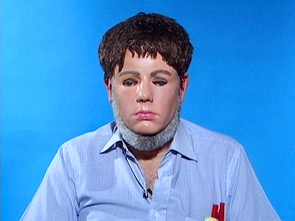In spring 2009, Musée Rodin is putting the spotlight on the special art of the portrait through two exhibitions. The first one, « la Fabrique du portrait, Rodin face à ses modèles », is a a creative laboratory but also a social insight that invites you to discover the considerable but little-known work of Rodin the portraitist. It highlights the artist’s creative process and approach in building a portrait. The second one, « Confessions / Portraits, videos », is a contemporary extension. It presents two videos by the British artist Gillian Wearing.
Playing with materials and scales
Modelled out of the earth itself, the faces of Baudelaire, Clemenceau and Balzac appear alongside the faces of the bourgeoisie of the end of the 19th century. For this event, the museum has taken many restored pieces out of storage, some of which are being shown to the public for the first time. Public or private, commemorative or intimate, the sculptor created a great diversity of portraits throughout his career. Artists, politicians, bankers, women who were loved, women of the world, French and foreign, all faces of Rodin’s time, immortalized in material form, gathered in one single exhibition. To achieve the physical and emotional characteristics of the subject portrayed, Rodin works the clay directly from real-life sketches or photographs. Using marble, plaster, bronze or baked clay, creating deformed necks and large foreheads, the sculptor plays with materials and scales, searching for a “cerebral anatomy”, to embody the very essence of his subject.
To look alike or not
However, the construction of his portraits results from a wider reflection on the relationship between the particular and the general, between the type and the individual. From the model, Rodin defines a type: the lines of the face are simplified or enlarged, the detail and the particular give way to the general. To create the posthumous portrait of Balzac, Rodin uses a carter from Touraine whose features, typical of the region, evoke those of the writer for him. The face of Baudelaire is also fashioned from the face of a substitute model. Faced with his portrait, Clemenceau said: “That’s not me”. But it’s undoubtedly in this distance between the type and the individual, between the subject portrayed and the final result that all the sculptor’s power of interpretation and symbolisation is expressed. “Clemenceau sees himself as he really is. I see him as part of his legend” Rodin explained.
GILLIAN WEARING
CONFESSIONS / PORTRAITS, VIDEOS
In parallel to Rodin’s work, British artist Gillian Wearing, born in 1963 in Birmingham, offers a contemporary vision of the portrait. In an almost anthropologic approach, her videos stage men and women, shot in their most intimate moments. The artist uses ordinary individuals as well as actors, in a constant back-and-forth between staging daily life and documentary-type exploration. She thus blurs the borders between reality and fiction, between public and private spaces. Trauma and Secrets and Lies are presented in what the artist calls a «confessional box», a closed space in the intimacy of which the spectator is invited to penetrate. Of course the whole structure echoes Judeo-Christian culture, psychoanalysis and ordinary voyeurism proper to the human being. Here Gillian Wearing pushes the strategies of self-exhibition to its extreme limits, but our voyeur impulses are thwarted by recurring to the mask and by the ambiguity inherent to images and to speech. The artist deconstructs and thus reveals all the complexity of the notions of identity and representation.
Illustration: Gillian Wearing Trauma, colour video with sound (30 minutes) - edition of 5 + 2 AP - 2000, courtesy Maureen Paley, London, Collection du musée d'Art moderne de la Ville de Paris
To see more illustrations, click on VERSION FRANCAISE at the top of this page
|



